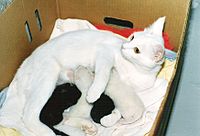
Photo from wikipedia
Changes in ACTH challenge test characteristics in dairy cows changing their physiological status at different lactational stages and different feeding levels were not investigated in terms of repeatability yet. In… Click to show full abstract
Changes in ACTH challenge test characteristics in dairy cows changing their physiological status at different lactational stages and different feeding levels were not investigated in terms of repeatability yet. In 23 multiparous Holstein cows (10 cows fed a sole fresh herbage diet without concentrate, 13 cows fed with concentrate), three ACTH challenge tests were performed: once during pregnancy shortly prior to drying off (T1), and in week 3 (T2) and 8 (T3) after parturition. Test characteristics were correlated to performance and metabolic parameters: DMI, BW, energy balance (EB), plasma concentrations of free fatty acids (NEFA) and beta-hydroxybutyrate (BHB). Basal plasma cortisol concentrations were higher at T1 compared with T2 and T3 (p < .05). The adrenal cortex sensitivity (expressed as total AUC (AUCt ) of cortisol response after ACTH application) was lowest at T2 compared with T1 and T3 (p < .05). Ranking of the individual animals' responses was not repeatable between time points of the ACTH tests. Enhancing the energy deficiency during early lactation by omission of concentrate did not affect baseline cortisol concentrations in plasma, but decreased peak height at T2 (p < .05). Baseline plasma cortisol concentrations were positively correlated with cortisol peak values after ACTH application, previous lactation performance, milk yield and BW (p < .05). The AUCt was positively correlated with baseline cortisol concentrations, EB and DMI. Cortisol release after ACTH injection was lower in animals with high plasma concentrations of NEFA, BHB and with higher contents of fat and free fatty acids in milk (p < .05). Cortisol peak height after ACTH administration was higher in cows with a more positive EB, higher DMI and lower plasma concentrations of NEFA and BHB. In summary, cortisol responses to ACTH challenges in this study were not repeatable in dairy cows changing their physiological status.
Journal Title: Journal of Animal Physiology and Animal Nutrition
Year Published: 2018
Link to full text (if available)
Share on Social Media: Sign Up to like & get
recommendations!